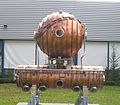 |

Microcosm or CERN Museum was an interactive exhibition presenting the work of the CERN particle physics laboratory and its flagship accelerator the Large Hadron Collider (LHC). It first opened to the public in 1990 and closed permanently in September 2022, to be replaced by the CERN Science Gateway in 2023. [1] The final version of the exhibition opened in January 2016, [2] developed by CERN in collaboration with Spanish design team Indissoluble. [3]












